Personal Hygiene: Preventing Illness in Elderly Residential Care Homes
VerifiedAdded on 2019/12/03
|33
|6778
|175
Report
AI Summary
This report investigates the crucial role of personal hygiene in the health and well-being of elderly individuals residing in care homes within London Boroughs. The study, conducted from the perspective of students in a London college, explores the relationship between personal hygiene practices and the occurrence of illnesses among elderly service users, as well as its impact on their non-health-related quality of life. Employing a positivism theory approach, the research utilized a questionnaire survey and quantitative data analysis, specifically one-way ANOVA. The findings reveal a significant inverse relationship between personal hygiene levels and susceptibility to illness. The report includes a comprehensive literature review, detailed methodology, findings, discussion, and recommendations, offering valuable insights into the importance of maintaining personal hygiene standards to prevent illnesses and improve the overall quality of life for elderly residents. The report underscores the importance of personal hygiene in promoting both physical and mental well-being, dignity, and self-respect among elderly individuals.
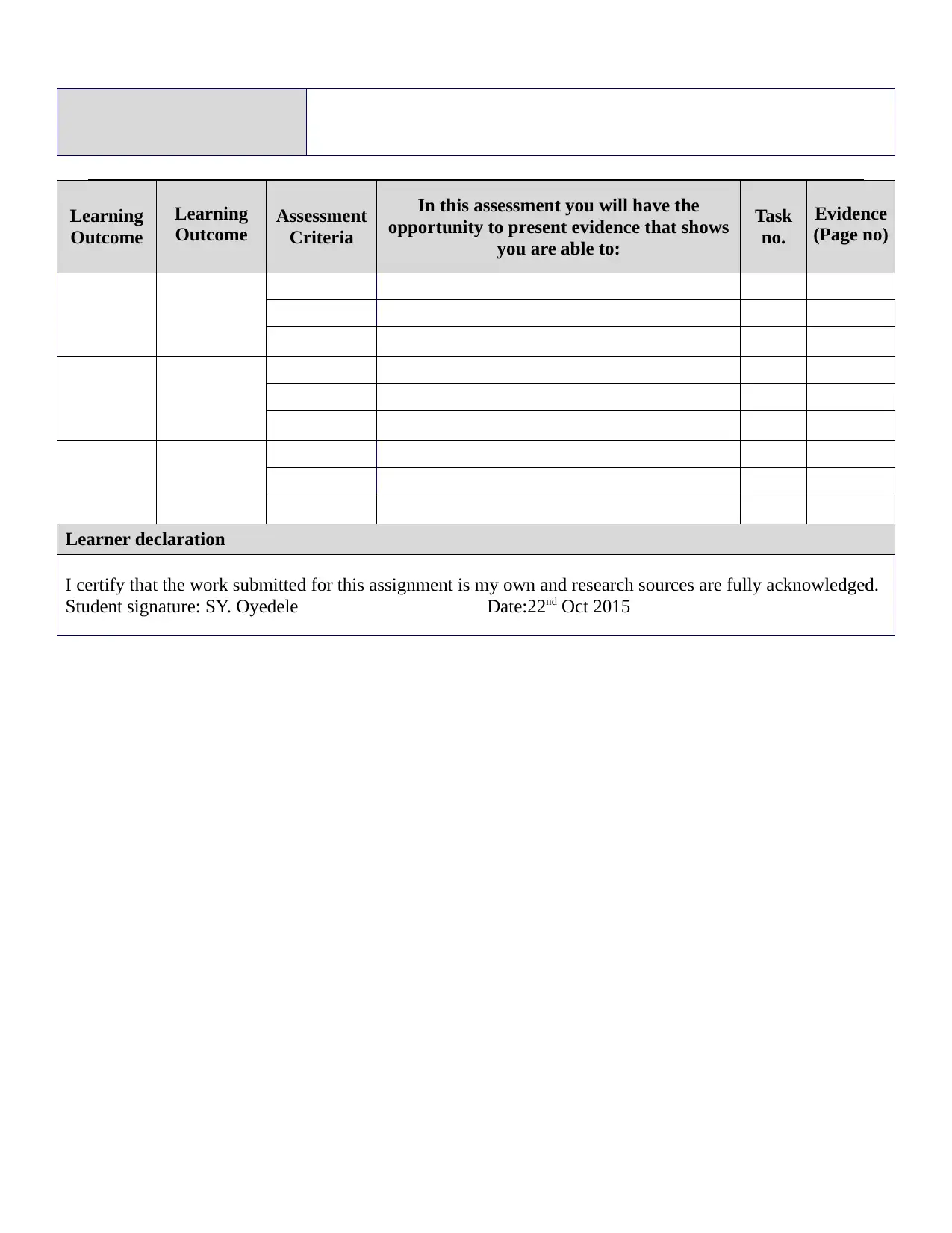
Learning
Outcome
Learning
Outcome Assessment
Criteria
In this assessment you will have the
opportunity to present evidence that shows
you are able to:
Task
no.
Evidence
(Page no)
Learner declaration
I certify that the work submitted for this assignment is my own and research sources are fully acknowledged.
Student signature: SY. Oyedele Date:22nd Oct 2015
Outcome
Learning
Outcome Assessment
Criteria
In this assessment you will have the
opportunity to present evidence that shows
you are able to:
Task
no.
Evidence
(Page no)
Learner declaration
I certify that the work submitted for this assignment is my own and research sources are fully acknowledged.
Student signature: SY. Oyedele Date:22nd Oct 2015
Paraphrase This Document
Need a fresh take? Get an instant paraphrase of this document with our AI Paraphraser


Abstract
Topic: Personal hygiene in elderly service users in home care. Purpose of the study: Does personal
hygiene play in preventing illnesses and improving overall quality of life of residential care homes in
London Boroughs for the service users: a perception of students in a London college?
Methodology: It is a very important section of conducting any research investigation primarily because
it guides and directs the researcher to perform the study in an effective manner and accomplishing aim
of the study easily. For this investigation, positivism theory was used, according to which the
researcher had a very limited connection with the study itself, rather scholar focused more on process
of data collection and analysis. Further, data was gathered from two sources – primary and secondary.
Primary data was collected through questionnaire survey technique. While data was analysed through
quantitative technique of 1-way ANOVA analysis.
Findings: there is a significant relationship between personal hygiene levels and susceptibility to
illness.
Conclusion: Through this research study, it can be concluded that personal hygiene levels and
susceptibility to illnesses share inverse or opposite relationship with one another.
Topic: Personal hygiene in elderly service users in home care. Purpose of the study: Does personal
hygiene play in preventing illnesses and improving overall quality of life of residential care homes in
London Boroughs for the service users: a perception of students in a London college?
Methodology: It is a very important section of conducting any research investigation primarily because
it guides and directs the researcher to perform the study in an effective manner and accomplishing aim
of the study easily. For this investigation, positivism theory was used, according to which the
researcher had a very limited connection with the study itself, rather scholar focused more on process
of data collection and analysis. Further, data was gathered from two sources – primary and secondary.
Primary data was collected through questionnaire survey technique. While data was analysed through
quantitative technique of 1-way ANOVA analysis.
Findings: there is a significant relationship between personal hygiene levels and susceptibility to
illness.
Conclusion: Through this research study, it can be concluded that personal hygiene levels and
susceptibility to illnesses share inverse or opposite relationship with one another.
⊘ This is a preview!⊘
Do you want full access?
Subscribe today to unlock all pages.

Trusted by 1+ million students worldwide

Acknowledgement I would like
to express the deepest appreciation to my Lecturer who has the attitude and the substance of a genius:
he continually and convincingly conveyed a spirit of adventure in regard to research and an excitement
in regard to teaching. Without his guidance and persistent help this dissertation would not have been
possible. I also say a big thank you to my colleagues who participate to make the Research a success.
to express the deepest appreciation to my Lecturer who has the attitude and the substance of a genius:
he continually and convincingly conveyed a spirit of adventure in regard to research and an excitement
in regard to teaching. Without his guidance and persistent help this dissertation would not have been
possible. I also say a big thank you to my colleagues who participate to make the Research a success.
Paraphrase This Document
Need a fresh take? Get an instant paraphrase of this document with our AI Paraphraser

Table of Content
Chapter 1: introduction..............................................................................................................................5
1.0 Introduction and Background.....................................................................................................6
1.1 Research Aim..............................................................................................................................6
1.2 Research Objectives....................................................................................................................6
1.3 Research Question......................................................................................................................6
Chapter 2: literature review..........................................................................................................................
2.0 Introduction................................................................................................................................7
2.1 Importance of personal hygiene among elderly people..............................................................7
2.2 Role of personal hygiene in reducing occurrences of illness among elderly people..................8
2.3 Effect of personal hygiene on non-health-related quality of life among elderly people............8
2.4 Conclusion..................................................................................................................................9
CHAPTER 3: RESEARCH METHODOLOGY.....................................................................................10
3.0 Introduction..............................................................................................................................10
3.1 Theoretical Perspective.............................................................................................................10
3.2 Research Design.......................................................................................................................10
3.3 Data Collection.........................................................................................................................11
3.4 Sampling...................................................................................................................................11
3.5 Data Analysis............................................................................................................................11
3.6 Reliability and validity..............................................................................................................11
3.7 Research Limitations................................................................................................................12
3.8 Overcoming Limitations...........................................................................................................12
3.9 Ethical Considerations..............................................................................................................12
3.10 Research Timeline..................................................................................................................12
CHAPTER 4: FINDINGS AND ANALYSIS .........................................................................................14
4.0 Introduction..............................................................................................................................14
4.1 Findings & Analysis.................................................................................................................23
CHAPTER 5: DISCUSSION...................................................................................................................25
5.0 Introduction..............................................................................................................................25
5.1 Discussion.................................................................................................................................25
CHAPTER 6: CONCLSION AND RECOMMENDATIONS.................................................................27
6.0 Introduction..............................................................................................................................27
6.1 Conclusion................................................................................................................................27
6.2 Recommendations.....................................................................................................................27
REFERENCES.........................................................................................................................................28
APPENDIX..............................................................................................................................................30
Appendix 1: Questionnaire.............................................................................................................31
Appendix 2: Consent to Participate in the study............................................................................32
Chapter 1: introduction..............................................................................................................................5
1.0 Introduction and Background.....................................................................................................6
1.1 Research Aim..............................................................................................................................6
1.2 Research Objectives....................................................................................................................6
1.3 Research Question......................................................................................................................6
Chapter 2: literature review..........................................................................................................................
2.0 Introduction................................................................................................................................7
2.1 Importance of personal hygiene among elderly people..............................................................7
2.2 Role of personal hygiene in reducing occurrences of illness among elderly people..................8
2.3 Effect of personal hygiene on non-health-related quality of life among elderly people............8
2.4 Conclusion..................................................................................................................................9
CHAPTER 3: RESEARCH METHODOLOGY.....................................................................................10
3.0 Introduction..............................................................................................................................10
3.1 Theoretical Perspective.............................................................................................................10
3.2 Research Design.......................................................................................................................10
3.3 Data Collection.........................................................................................................................11
3.4 Sampling...................................................................................................................................11
3.5 Data Analysis............................................................................................................................11
3.6 Reliability and validity..............................................................................................................11
3.7 Research Limitations................................................................................................................12
3.8 Overcoming Limitations...........................................................................................................12
3.9 Ethical Considerations..............................................................................................................12
3.10 Research Timeline..................................................................................................................12
CHAPTER 4: FINDINGS AND ANALYSIS .........................................................................................14
4.0 Introduction..............................................................................................................................14
4.1 Findings & Analysis.................................................................................................................23
CHAPTER 5: DISCUSSION...................................................................................................................25
5.0 Introduction..............................................................................................................................25
5.1 Discussion.................................................................................................................................25
CHAPTER 6: CONCLSION AND RECOMMENDATIONS.................................................................27
6.0 Introduction..............................................................................................................................27
6.1 Conclusion................................................................................................................................27
6.2 Recommendations.....................................................................................................................27
REFERENCES.........................................................................................................................................28
APPENDIX..............................................................................................................................................30
Appendix 1: Questionnaire.............................................................................................................31
Appendix 2: Consent to Participate in the study............................................................................32
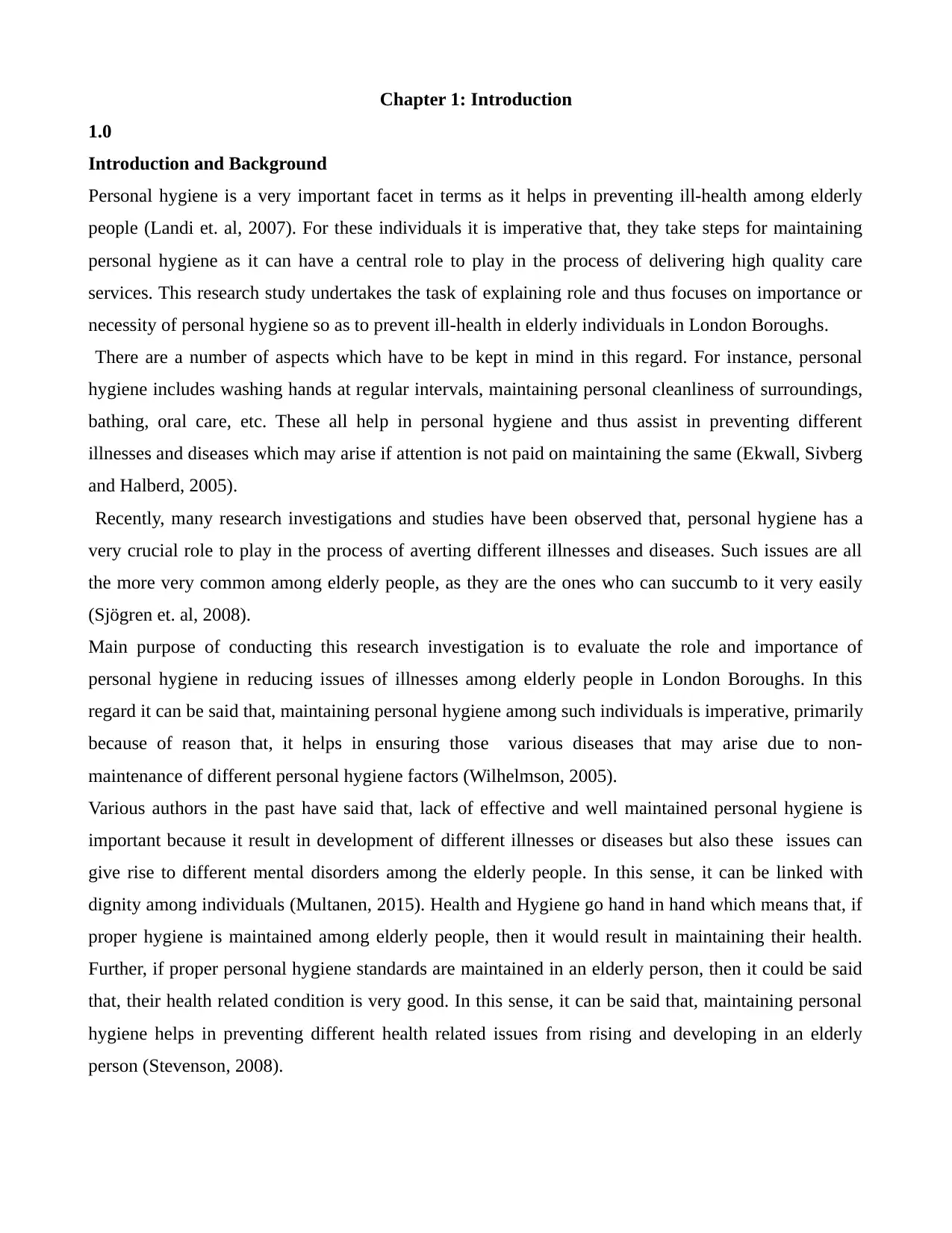
Chapter 1: Introduction
1.0
Introduction and Background
Personal hygiene is a very important facet in terms as it helps in preventing ill-health among elderly
people (Landi et. al, 2007). For these individuals it is imperative that, they take steps for maintaining
personal hygiene as it can have a central role to play in the process of delivering high quality care
services. This research study undertakes the task of explaining role and thus focuses on importance or
necessity of personal hygiene so as to prevent ill-health in elderly individuals in London Boroughs.
There are a number of aspects which have to be kept in mind in this regard. For instance, personal
hygiene includes washing hands at regular intervals, maintaining personal cleanliness of surroundings,
bathing, oral care, etc. These all help in personal hygiene and thus assist in preventing different
illnesses and diseases which may arise if attention is not paid on maintaining the same (Ekwall, Sivberg
and Halberd, 2005).
Recently, many research investigations and studies have been observed that, personal hygiene has a
very crucial role to play in the process of averting different illnesses and diseases. Such issues are all
the more very common among elderly people, as they are the ones who can succumb to it very easily
(Sjögren et. al, 2008).
Main purpose of conducting this research investigation is to evaluate the role and importance of
personal hygiene in reducing issues of illnesses among elderly people in London Boroughs. In this
regard it can be said that, maintaining personal hygiene among such individuals is imperative, primarily
because of reason that, it helps in ensuring those various diseases that may arise due to non-
maintenance of different personal hygiene factors (Wilhelmson, 2005).
Various authors in the past have said that, lack of effective and well maintained personal hygiene is
important because it result in development of different illnesses or diseases but also these issues can
give rise to different mental disorders among the elderly people. In this sense, it can be linked with
dignity among individuals (Multanen, 2015). Health and Hygiene go hand in hand which means that, if
proper hygiene is maintained among elderly people, then it would result in maintaining their health.
Further, if proper personal hygiene standards are maintained in an elderly person, then it could be said
that, their health related condition is very good. In this sense, it can be said that, maintaining personal
hygiene helps in preventing different health related issues from rising and developing in an elderly
person (Stevenson, 2008).
1.0
Introduction and Background
Personal hygiene is a very important facet in terms as it helps in preventing ill-health among elderly
people (Landi et. al, 2007). For these individuals it is imperative that, they take steps for maintaining
personal hygiene as it can have a central role to play in the process of delivering high quality care
services. This research study undertakes the task of explaining role and thus focuses on importance or
necessity of personal hygiene so as to prevent ill-health in elderly individuals in London Boroughs.
There are a number of aspects which have to be kept in mind in this regard. For instance, personal
hygiene includes washing hands at regular intervals, maintaining personal cleanliness of surroundings,
bathing, oral care, etc. These all help in personal hygiene and thus assist in preventing different
illnesses and diseases which may arise if attention is not paid on maintaining the same (Ekwall, Sivberg
and Halberd, 2005).
Recently, many research investigations and studies have been observed that, personal hygiene has a
very crucial role to play in the process of averting different illnesses and diseases. Such issues are all
the more very common among elderly people, as they are the ones who can succumb to it very easily
(Sjögren et. al, 2008).
Main purpose of conducting this research investigation is to evaluate the role and importance of
personal hygiene in reducing issues of illnesses among elderly people in London Boroughs. In this
regard it can be said that, maintaining personal hygiene among such individuals is imperative, primarily
because of reason that, it helps in ensuring those various diseases that may arise due to non-
maintenance of different personal hygiene factors (Wilhelmson, 2005).
Various authors in the past have said that, lack of effective and well maintained personal hygiene is
important because it result in development of different illnesses or diseases but also these issues can
give rise to different mental disorders among the elderly people. In this sense, it can be linked with
dignity among individuals (Multanen, 2015). Health and Hygiene go hand in hand which means that, if
proper hygiene is maintained among elderly people, then it would result in maintaining their health.
Further, if proper personal hygiene standards are maintained in an elderly person, then it could be said
that, their health related condition is very good. In this sense, it can be said that, maintaining personal
hygiene helps in preventing different health related issues from rising and developing in an elderly
person (Stevenson, 2008).
⊘ This is a preview!⊘
Do you want full access?
Subscribe today to unlock all pages.

Trusted by 1+ million students worldwide

1.1
Research Aim
The aim of this study is to investigate contribution of personal hygiene in minimising occurrence of
illness among Elderly service users in the residential care homes in London boroughs: a perception of
students in a London college.
1.2
Research Objectives
Following are the objectives fulfilling which will help in meeting above stated aim of the study:
To determine if there is a relationship between engagement in personal hygiene practices and
the occurrence of illness among elderly service users who are vulnerable in residential care
homes in the London Boroughs.
To ascertain the effect of personal hygiene on non-health-related quality of life of elderly
service users who have vulnerability in the residential care homes in the London Boroughs?
1.3
Research Question
What role does Personal hygiene play in preventing illnesses and improving overall quality of life of
residential care homes in London Boroughs for the service users: a perception of students in a London
college? Determining answer to this research question will help in fulfilling aim and objectives of this
research study.
Research Aim
The aim of this study is to investigate contribution of personal hygiene in minimising occurrence of
illness among Elderly service users in the residential care homes in London boroughs: a perception of
students in a London college.
1.2
Research Objectives
Following are the objectives fulfilling which will help in meeting above stated aim of the study:
To determine if there is a relationship between engagement in personal hygiene practices and
the occurrence of illness among elderly service users who are vulnerable in residential care
homes in the London Boroughs.
To ascertain the effect of personal hygiene on non-health-related quality of life of elderly
service users who have vulnerability in the residential care homes in the London Boroughs?
1.3
Research Question
What role does Personal hygiene play in preventing illnesses and improving overall quality of life of
residential care homes in London Boroughs for the service users: a perception of students in a London
college? Determining answer to this research question will help in fulfilling aim and objectives of this
research study.
Paraphrase This Document
Need a fresh take? Get an instant paraphrase of this document with our AI Paraphraser

Chapter 2: literature review
2.0
Introduction
For conducting any research investigation in an effective manner, it is important to obtain thorough
information regarding the topic under study. In this way, researcher can increase knowledge base and
use different kind of information in a proper manner so as to ensure that aim of the research is attained.
Through the chapter of literature review, various past studies and investigations pertaining to the topic
are assessed in compliance with aim and objectives of present research. Through these ways readers
can also obtain thorough knowledge about topic and understand various technical jargon and
statements. In this section, different studies conducted in the past associated with the topic have been
studied and evaluated.
2.1 Importance of personal hygiene among elderly people
Personal Hygiene is one of the most important aspects of elderly care, as it determines effectiveness
and efficiency of care services which is being provided to such individuals. In this regard Willis et. al
(2006) states that maintaining personal hygiene can help in ensuring that proper care is delivered to
elderly people and also that, they are able to lead a comfortable as well as a healthy life (Evren, 2011).
In recent years it has been observed that, health care standards among elder people have reduced
drastically. This has led to increased chances by which people fall prey to different diseases and
illnesses has increased substantially, as recalled by Ekwall, Sivberg and Hallberg (2005). Thus it can be
said that, good personal hygiene will help in not only promoting psychological well-being in concerned
individuals but also help in maintaining good physical health (Hassan, 2012). Sjögren et al. (2008)
reviewed the estimates and methodological quality of randomized controlled trails (RCTs). During this
study, RCTs gave positive effects of oral hygiene on diseases such pneumonia and respiratory tract
infection among elderly people. On the basis of this research it can be said that, maintaining certain
personal hygiene levels and standards is very important among elderly people (Importance of Good
Personal Hygiene, 2010). Further, Stevenson (2008) in his study states that, personal hygiene is also
related with aspects of dignity, self respect, etc. Herein the author suggests that, for elder people it is
imperative to maintain standards of personal hygiene. This is as it is directly related with their image
among people. For instance, if such an individual maintains such standards, like if they cut their nails
or bath every day, then they would feel good about themselves and be able to present a positive image
among people (Saga, 2005).
2.0
Introduction
For conducting any research investigation in an effective manner, it is important to obtain thorough
information regarding the topic under study. In this way, researcher can increase knowledge base and
use different kind of information in a proper manner so as to ensure that aim of the research is attained.
Through the chapter of literature review, various past studies and investigations pertaining to the topic
are assessed in compliance with aim and objectives of present research. Through these ways readers
can also obtain thorough knowledge about topic and understand various technical jargon and
statements. In this section, different studies conducted in the past associated with the topic have been
studied and evaluated.
2.1 Importance of personal hygiene among elderly people
Personal Hygiene is one of the most important aspects of elderly care, as it determines effectiveness
and efficiency of care services which is being provided to such individuals. In this regard Willis et. al
(2006) states that maintaining personal hygiene can help in ensuring that proper care is delivered to
elderly people and also that, they are able to lead a comfortable as well as a healthy life (Evren, 2011).
In recent years it has been observed that, health care standards among elder people have reduced
drastically. This has led to increased chances by which people fall prey to different diseases and
illnesses has increased substantially, as recalled by Ekwall, Sivberg and Hallberg (2005). Thus it can be
said that, good personal hygiene will help in not only promoting psychological well-being in concerned
individuals but also help in maintaining good physical health (Hassan, 2012). Sjögren et al. (2008)
reviewed the estimates and methodological quality of randomized controlled trails (RCTs). During this
study, RCTs gave positive effects of oral hygiene on diseases such pneumonia and respiratory tract
infection among elderly people. On the basis of this research it can be said that, maintaining certain
personal hygiene levels and standards is very important among elderly people (Importance of Good
Personal Hygiene, 2010). Further, Stevenson (2008) in his study states that, personal hygiene is also
related with aspects of dignity, self respect, etc. Herein the author suggests that, for elder people it is
imperative to maintain standards of personal hygiene. This is as it is directly related with their image
among people. For instance, if such an individual maintains such standards, like if they cut their nails
or bath every day, then they would feel good about themselves and be able to present a positive image
among people (Saga, 2005).
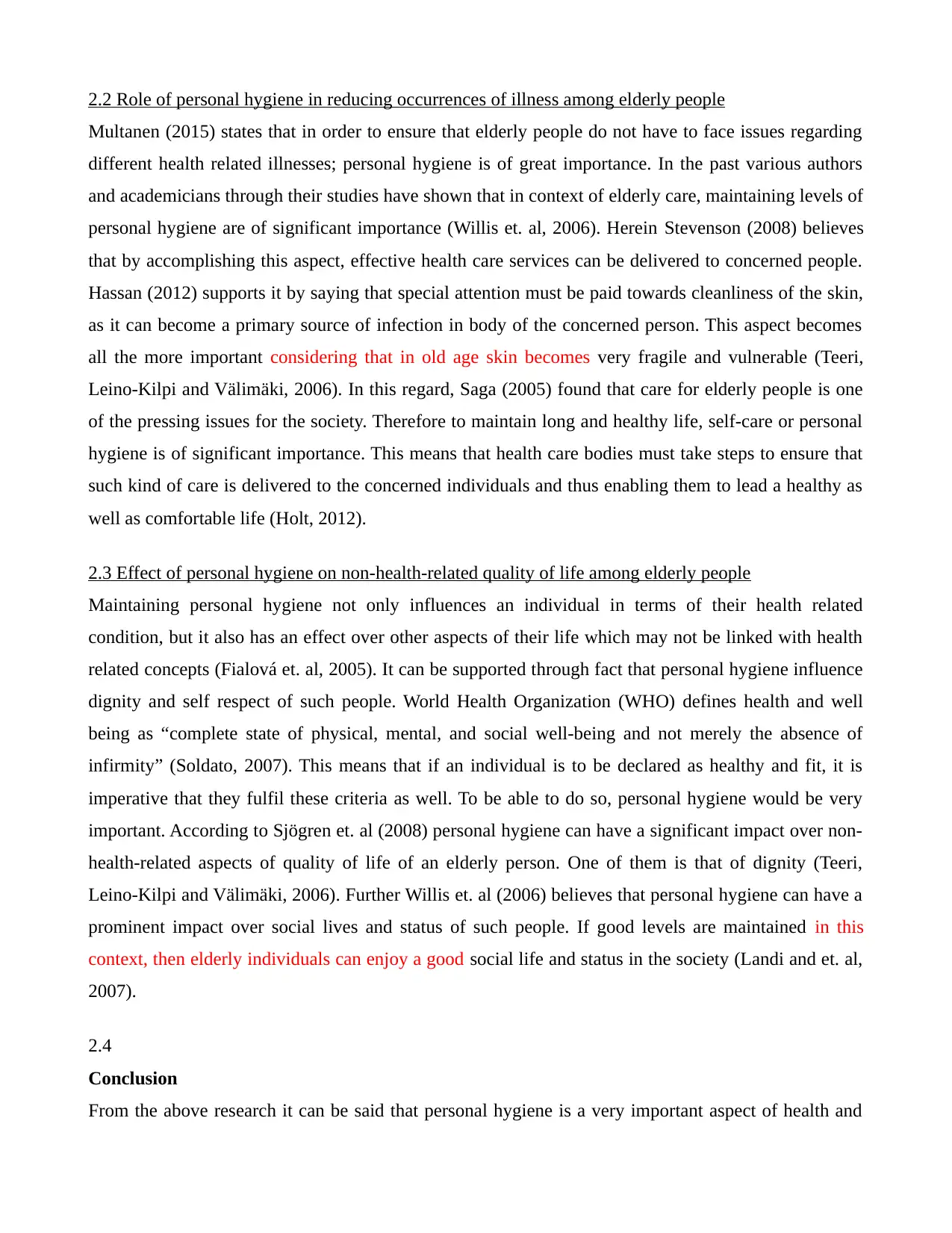
2.2 Role of personal hygiene in reducing occurrences of illness among elderly people
Multanen (2015) states that in order to ensure that elderly people do not have to face issues regarding
different health related illnesses; personal hygiene is of great importance. In the past various authors
and academicians through their studies have shown that in context of elderly care, maintaining levels of
personal hygiene are of significant importance (Willis et. al, 2006). Herein Stevenson (2008) believes
that by accomplishing this aspect, effective health care services can be delivered to concerned people.
Hassan (2012) supports it by saying that special attention must be paid towards cleanliness of the skin,
as it can become a primary source of infection in body of the concerned person. This aspect becomes
all the more important considering that in old age skin becomes very fragile and vulnerable (Teeri,
Leino-Kilpi and Välimäki, 2006). In this regard, Saga (2005) found that care for elderly people is one
of the pressing issues for the society. Therefore to maintain long and healthy life, self-care or personal
hygiene is of significant importance. This means that health care bodies must take steps to ensure that
such kind of care is delivered to the concerned individuals and thus enabling them to lead a healthy as
well as comfortable life (Holt, 2012).
2.3 Effect of personal hygiene on non-health-related quality of life among elderly people
Maintaining personal hygiene not only influences an individual in terms of their health related
condition, but it also has an effect over other aspects of their life which may not be linked with health
related concepts (Fialová et. al, 2005). It can be supported through fact that personal hygiene influence
dignity and self respect of such people. World Health Organization (WHO) defines health and well
being as “complete state of physical, mental, and social well-being and not merely the absence of
infirmity” (Soldato, 2007). This means that if an individual is to be declared as healthy and fit, it is
imperative that they fulfil these criteria as well. To be able to do so, personal hygiene would be very
important. According to Sjögren et. al (2008) personal hygiene can have a significant impact over non-
health-related aspects of quality of life of an elderly person. One of them is that of dignity (Teeri,
Leino-Kilpi and Välimäki, 2006). Further Willis et. al (2006) believes that personal hygiene can have a
prominent impact over social lives and status of such people. If good levels are maintained in this
context, then elderly individuals can enjoy a good social life and status in the society (Landi and et. al,
2007).
2.4
Conclusion
From the above research it can be said that personal hygiene is a very important aspect of health and
Multanen (2015) states that in order to ensure that elderly people do not have to face issues regarding
different health related illnesses; personal hygiene is of great importance. In the past various authors
and academicians through their studies have shown that in context of elderly care, maintaining levels of
personal hygiene are of significant importance (Willis et. al, 2006). Herein Stevenson (2008) believes
that by accomplishing this aspect, effective health care services can be delivered to concerned people.
Hassan (2012) supports it by saying that special attention must be paid towards cleanliness of the skin,
as it can become a primary source of infection in body of the concerned person. This aspect becomes
all the more important considering that in old age skin becomes very fragile and vulnerable (Teeri,
Leino-Kilpi and Välimäki, 2006). In this regard, Saga (2005) found that care for elderly people is one
of the pressing issues for the society. Therefore to maintain long and healthy life, self-care or personal
hygiene is of significant importance. This means that health care bodies must take steps to ensure that
such kind of care is delivered to the concerned individuals and thus enabling them to lead a healthy as
well as comfortable life (Holt, 2012).
2.3 Effect of personal hygiene on non-health-related quality of life among elderly people
Maintaining personal hygiene not only influences an individual in terms of their health related
condition, but it also has an effect over other aspects of their life which may not be linked with health
related concepts (Fialová et. al, 2005). It can be supported through fact that personal hygiene influence
dignity and self respect of such people. World Health Organization (WHO) defines health and well
being as “complete state of physical, mental, and social well-being and not merely the absence of
infirmity” (Soldato, 2007). This means that if an individual is to be declared as healthy and fit, it is
imperative that they fulfil these criteria as well. To be able to do so, personal hygiene would be very
important. According to Sjögren et. al (2008) personal hygiene can have a significant impact over non-
health-related aspects of quality of life of an elderly person. One of them is that of dignity (Teeri,
Leino-Kilpi and Välimäki, 2006). Further Willis et. al (2006) believes that personal hygiene can have a
prominent impact over social lives and status of such people. If good levels are maintained in this
context, then elderly individuals can enjoy a good social life and status in the society (Landi and et. al,
2007).
2.4
Conclusion
From the above research it can be said that personal hygiene is a very important aspect of health and
⊘ This is a preview!⊘
Do you want full access?
Subscribe today to unlock all pages.

Trusted by 1+ million students worldwide

social care for elderly people. During the study it was observed that maintaining personal hygiene
levels can help in improving dignity and self-respect levels in such individuals. Furthermore, personal
hygiene levels help in reducing occurrences of illness among elderly people and the way they lead their
lives. In addition to it, personal hygiene can influence social status and lives of elderly people.
levels can help in improving dignity and self-respect levels in such individuals. Furthermore, personal
hygiene levels help in reducing occurrences of illness among elderly people and the way they lead their
lives. In addition to it, personal hygiene can influence social status and lives of elderly people.
Paraphrase This Document
Need a fresh take? Get an instant paraphrase of this document with our AI Paraphraser
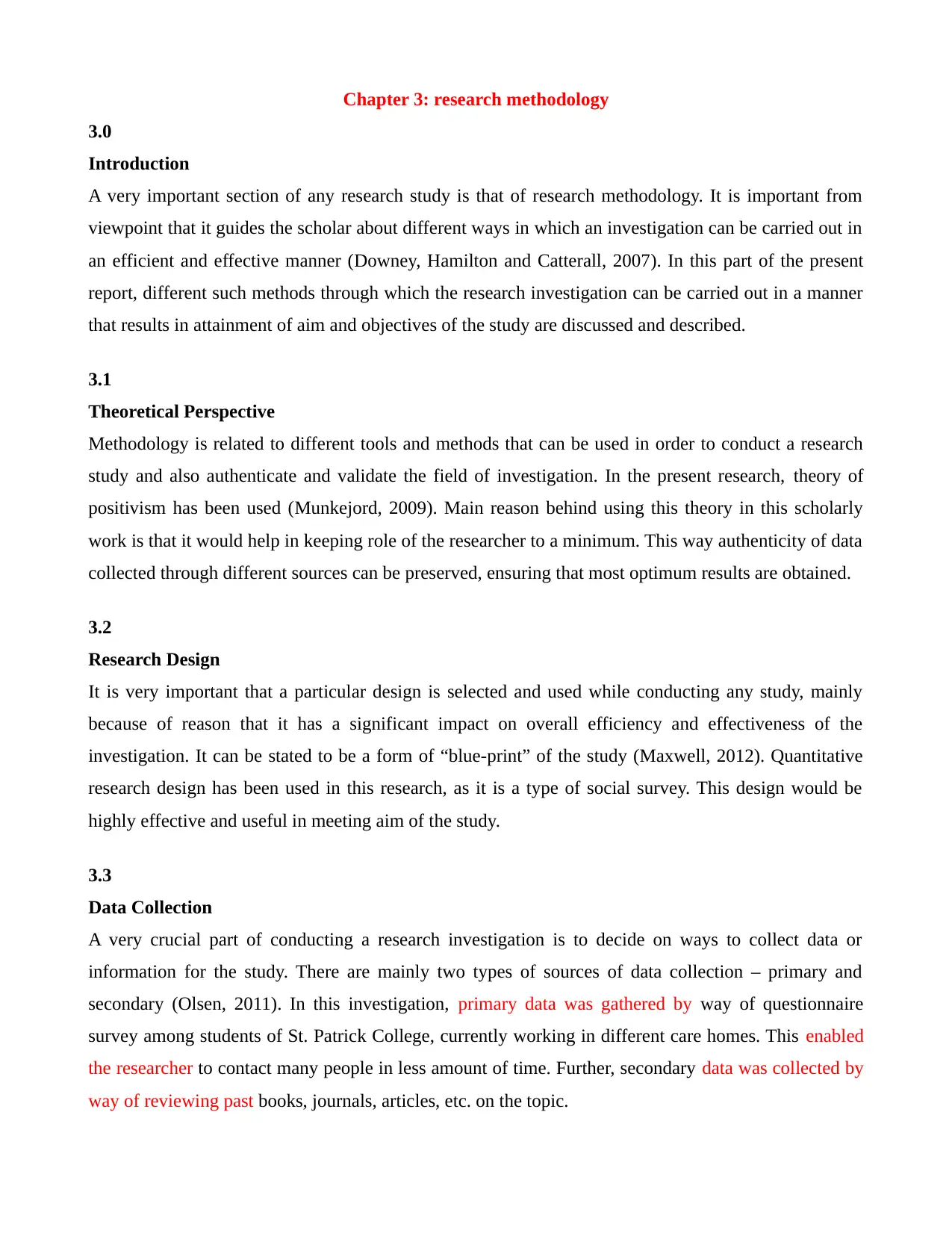
Chapter 3: research methodology
3.0
Introduction
A very important section of any research study is that of research methodology. It is important from
viewpoint that it guides the scholar about different ways in which an investigation can be carried out in
an efficient and effective manner (Downey, Hamilton and Catterall, 2007). In this part of the present
report, different such methods through which the research investigation can be carried out in a manner
that results in attainment of aim and objectives of the study are discussed and described.
3.1
Theoretical Perspective
Methodology is related to different tools and methods that can be used in order to conduct a research
study and also authenticate and validate the field of investigation. In the present research, theory of
positivism has been used (Munkejord, 2009). Main reason behind using this theory in this scholarly
work is that it would help in keeping role of the researcher to a minimum. This way authenticity of data
collected through different sources can be preserved, ensuring that most optimum results are obtained.
3.2
Research Design
It is very important that a particular design is selected and used while conducting any study, mainly
because of reason that it has a significant impact on overall efficiency and effectiveness of the
investigation. It can be stated to be a form of “blue-print” of the study (Maxwell, 2012). Quantitative
research design has been used in this research, as it is a type of social survey. This design would be
highly effective and useful in meeting aim of the study.
3.3
Data Collection
A very crucial part of conducting a research investigation is to decide on ways to collect data or
information for the study. There are mainly two types of sources of data collection – primary and
secondary (Olsen, 2011). In this investigation, primary data was gathered by way of questionnaire
survey among students of St. Patrick College, currently working in different care homes. This enabled
the researcher to contact many people in less amount of time. Further, secondary data was collected by
way of reviewing past books, journals, articles, etc. on the topic.
3.0
Introduction
A very important section of any research study is that of research methodology. It is important from
viewpoint that it guides the scholar about different ways in which an investigation can be carried out in
an efficient and effective manner (Downey, Hamilton and Catterall, 2007). In this part of the present
report, different such methods through which the research investigation can be carried out in a manner
that results in attainment of aim and objectives of the study are discussed and described.
3.1
Theoretical Perspective
Methodology is related to different tools and methods that can be used in order to conduct a research
study and also authenticate and validate the field of investigation. In the present research, theory of
positivism has been used (Munkejord, 2009). Main reason behind using this theory in this scholarly
work is that it would help in keeping role of the researcher to a minimum. This way authenticity of data
collected through different sources can be preserved, ensuring that most optimum results are obtained.
3.2
Research Design
It is very important that a particular design is selected and used while conducting any study, mainly
because of reason that it has a significant impact on overall efficiency and effectiveness of the
investigation. It can be stated to be a form of “blue-print” of the study (Maxwell, 2012). Quantitative
research design has been used in this research, as it is a type of social survey. This design would be
highly effective and useful in meeting aim of the study.
3.3
Data Collection
A very crucial part of conducting a research investigation is to decide on ways to collect data or
information for the study. There are mainly two types of sources of data collection – primary and
secondary (Olsen, 2011). In this investigation, primary data was gathered by way of questionnaire
survey among students of St. Patrick College, currently working in different care homes. This enabled
the researcher to contact many people in less amount of time. Further, secondary data was collected by
way of reviewing past books, journals, articles, etc. on the topic.
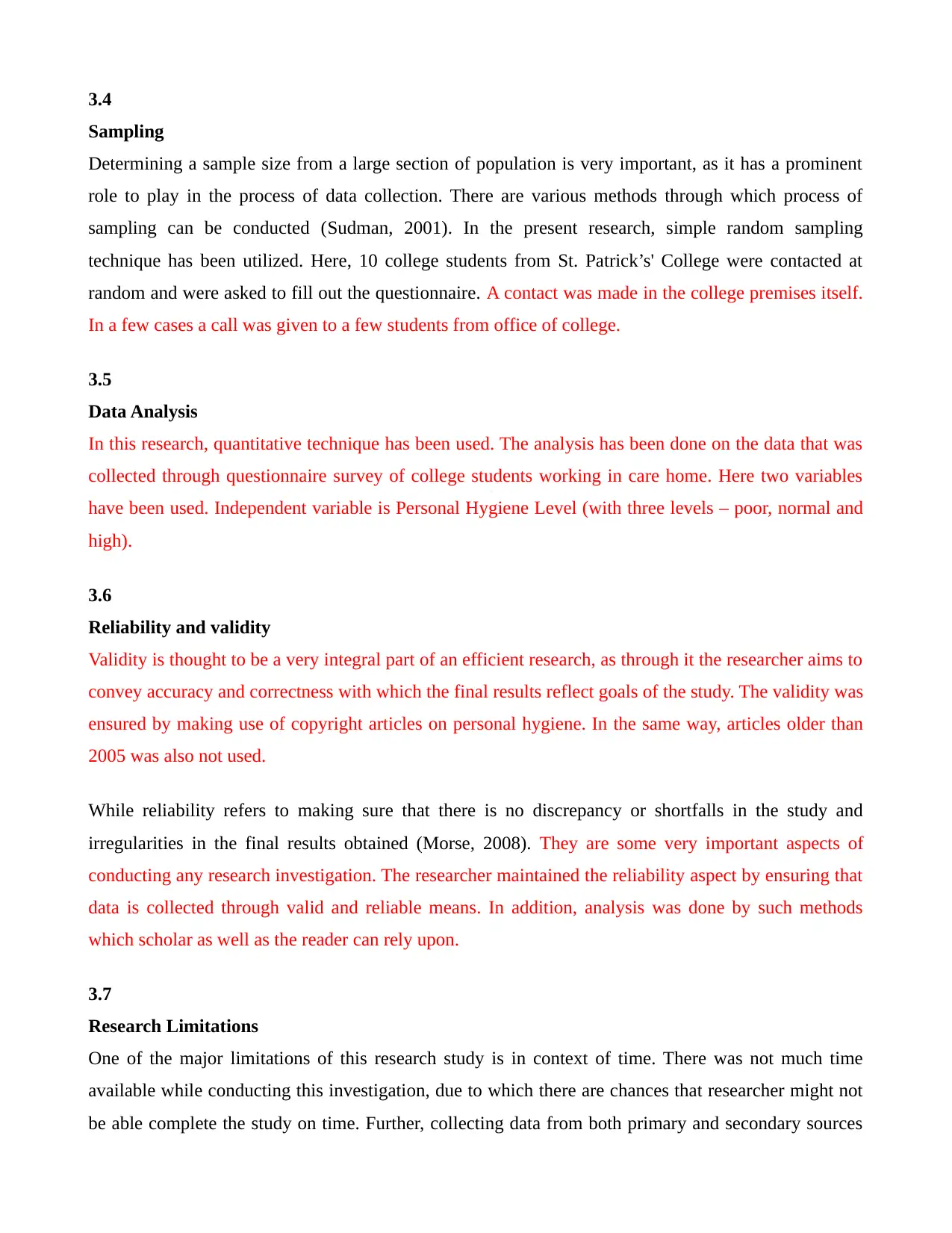
3.4
Sampling
Determining a sample size from a large section of population is very important, as it has a prominent
role to play in the process of data collection. There are various methods through which process of
sampling can be conducted (Sudman, 2001). In the present research, simple random sampling
technique has been utilized. Here, 10 college students from St. Patrick’s' College were contacted at
random and were asked to fill out the questionnaire. A contact was made in the college premises itself.
In a few cases a call was given to a few students from office of college.
3.5
Data Analysis
In this research, quantitative technique has been used. The analysis has been done on the data that was
collected through questionnaire survey of college students working in care home. Here two variables
have been used. Independent variable is Personal Hygiene Level (with three levels – poor, normal and
high).
3.6
Reliability and validity
Validity is thought to be a very integral part of an efficient research, as through it the researcher aims to
convey accuracy and correctness with which the final results reflect goals of the study. The validity was
ensured by making use of copyright articles on personal hygiene. In the same way, articles older than
2005 was also not used.
While reliability refers to making sure that there is no discrepancy or shortfalls in the study and
irregularities in the final results obtained (Morse, 2008). They are some very important aspects of
conducting any research investigation. The researcher maintained the reliability aspect by ensuring that
data is collected through valid and reliable means. In addition, analysis was done by such methods
which scholar as well as the reader can rely upon.
3.7
Research Limitations
One of the major limitations of this research study is in context of time. There was not much time
available while conducting this investigation, due to which there are chances that researcher might not
be able complete the study on time. Further, collecting data from both primary and secondary sources
Sampling
Determining a sample size from a large section of population is very important, as it has a prominent
role to play in the process of data collection. There are various methods through which process of
sampling can be conducted (Sudman, 2001). In the present research, simple random sampling
technique has been utilized. Here, 10 college students from St. Patrick’s' College were contacted at
random and were asked to fill out the questionnaire. A contact was made in the college premises itself.
In a few cases a call was given to a few students from office of college.
3.5
Data Analysis
In this research, quantitative technique has been used. The analysis has been done on the data that was
collected through questionnaire survey of college students working in care home. Here two variables
have been used. Independent variable is Personal Hygiene Level (with three levels – poor, normal and
high).
3.6
Reliability and validity
Validity is thought to be a very integral part of an efficient research, as through it the researcher aims to
convey accuracy and correctness with which the final results reflect goals of the study. The validity was
ensured by making use of copyright articles on personal hygiene. In the same way, articles older than
2005 was also not used.
While reliability refers to making sure that there is no discrepancy or shortfalls in the study and
irregularities in the final results obtained (Morse, 2008). They are some very important aspects of
conducting any research investigation. The researcher maintained the reliability aspect by ensuring that
data is collected through valid and reliable means. In addition, analysis was done by such methods
which scholar as well as the reader can rely upon.
3.7
Research Limitations
One of the major limitations of this research study is in context of time. There was not much time
available while conducting this investigation, due to which there are chances that researcher might not
be able complete the study on time. Further, collecting data from both primary and secondary sources
⊘ This is a preview!⊘
Do you want full access?
Subscribe today to unlock all pages.

Trusted by 1+ million students worldwide
1 out of 33
Related Documents
Your All-in-One AI-Powered Toolkit for Academic Success.
+13062052269
info@desklib.com
Available 24*7 on WhatsApp / Email
![[object Object]](/_next/static/media/star-bottom.7253800d.svg)
Unlock your academic potential
Copyright © 2020–2025 A2Z Services. All Rights Reserved. Developed and managed by ZUCOL.





